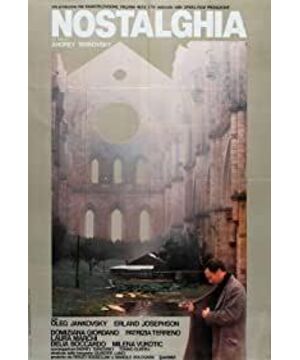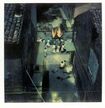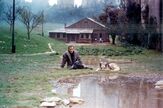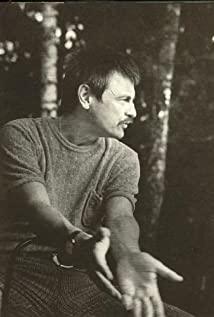The plot is summed up in one sentence: Russian poet Andrei went to Italy to search for the life footprints of Russian musician Sosnovsky. After meeting Dominic the "madman" who had locked his family in his house for seven years, he finally found music. Reasons for suicide at home.
The beauty of Tarkovsky's films has been recognized, and the subtlety of his stories and the profundity of his thoughts are even more amazing. Ta's literary attainment is very profound, which makes his films not only have the characteristics of beauty, but also have the reflection and pursuit of truth and goodness.
There are three important characters in Nostalgia: the poet Andrei, the Russian musician Sosnovsky, and the "madman" Dominic. Among them, the musician Sosnovsky does not have a shot from beginning to end, but his presence is crucial. Although "Nostalgia" tells the story of these three people, in essence, these three belong to the same person. Musicians are like a complete "shadow", while poets and "madmen" are like puzzle pieces. They use their own images of reality to piece together the complete outline of the "shadow" in front of the audience. Andre represents a question mark, and Dominic represents an answer, and together they solved a mystery like Sosnovsky.
Three "Saints" in "Nostalgia"
Poet Andre: At first, he was confused and questioned about his beliefs. After spiritual exploration and insight, he became a devout believer. Finally, he fell down in the hot spring pool due to an incurable disease.
"Mad" Dominic: Locked his family in a house for seven years, and finally set himself on fire.
Russian musician Sosnovsky: After living in Italy for a long time, he committed suicide when he returned home.
Why did Russian musician Sosnovsky, who lived in Italy, commit suicide after returning home? This should have been the suspense throughout the film, but Laota downplayed the suspense during the filming process to minimize the "control" and "manipulation" of the story suspense on the audience. Instead, through poetic pictures and soothing rhythms, The initiative of aesthetics and thinking is returned to the audience. Putting the audience on the same level as the creator is Tarkovsky's consistent aim, which reflects his great trust and respect for the audience.
The importance of figuring out the musician's suicide is that it directly answers the film's most fundamental question - what is "nostalgia"? If "nostalgia" is nostalgia for the motherland, then the Russian musician Sosnovsky, who has lived in Italy for a long time, should find happiness after returning home, but this is not the case. Because in Tarkovsky's eyes, the hometown is not a specific geographical location, but a beautiful country, where heaven is. "Nostalgia" is the yearning for this country and the pursuit of truth.
Poets, musicians and "madmen", they are all sober, hesitant, and seekers of truth, all of them will eventually perish. "Mad" Dominic is the key to the theme of the trio. He locked his family in the house for seven years to wait for the end of the world, not to hurt them, but precisely to protect them from the real world, because in the eyes of this "madman," The end" is near. He was a devout saint who believed that walking through the hot springs with a candle and making sure the candle didn't go out would save humanity. Out of desperation for the world, he shouted loudly to the "sleeping" people in the way of preaching, and finally set himself on fire, sharing the same path with the musician, revealing the real reason for the musician's suicide.
Tarkovsky is good at developing his exploration of truth through a poetic lens, and his expression is restrained and artistically beautiful. By switching between black and white and color lenses, he interweaves dreams with reality. Color can be deceiving, and what we "see with our own eyes" in the so-called "real world" may not be the truth of things. In Ta's films, the black and white images represent both the dream or the image in the mind and the essence of the world at the same time.
If the composer Debussy was good at depicting pictures with musical notes, then film master Andrei Tarkovsky was good at expressing poetry and ideas with pictures. Following poetic logic, he presents various metaphors and rich images to the audience through beautiful pictures.
1. The image of a lonely tree
Laota used the image of a tree at the beginning of "Nostalgia" and "Sacrifice", but the meaning is completely different. The tree in "Nostalgia" stands alone in the darkness and fog, just like the confused and hesitant heart of the poet Andre.
2. The image of the sparrow
In the church, a flock of sparrows flies out of the body of the Virgin Mary, implying that the prayers derive their joy, purity and freedom from their faith (as distinguished from "religion").
3. The image of hot springs and hot springs
Hot springs are like the secular world. People soak in hot springs for comfort and longevity. In the eyes of the world, the poet Andre is strange, while Dominic is a downright "madman".
4. Imagery of walking through a hot spring with a candle in hand
The poet André turned from skeptic to devout, igniting the fire of faith and trying to keep the flame of truth from dying out in a fallen world. Tarkovsky once again used the montage technique brilliantly to make the shot happen at the same time as "Mad" Dominic's speech in the square, forming a perfect echo and shocking.
5. Imagery of street ruins
Andre walked slowly through the abandoned street and fell into deep thinking. The external ruins of the city point to the degeneration and sinking of the inner spirit.
6. The house in the church (the most important image in the whole film)
At the last moment of his life, the poet Andre finally realized the true meaning of "nostalgia". The house in the church means a beautiful and kind country.
Throughout his life, Tay used dreamlike images to write poems and use them to explore: What is God? How should people face pain and how to deal with faith? How can we find wisdom and truth? In fact, all the saint characters in the film are the spiritual epitome of Tarkovsky, who, through self-sacrifice, light a path to the light for mankind.
View more about Nostalghia reviews











